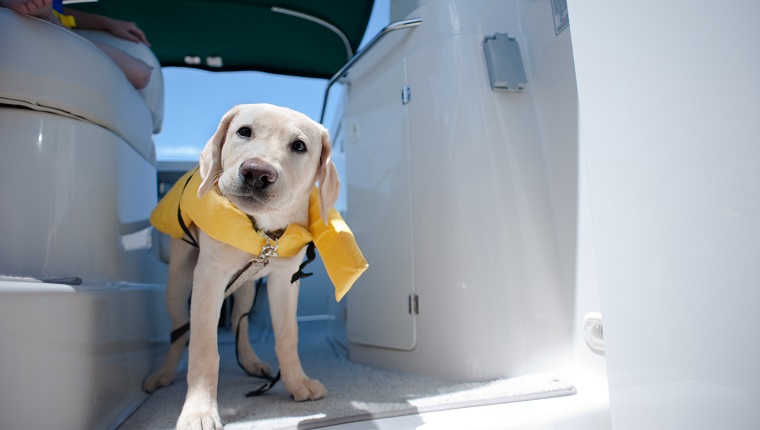Going Boating With Your Dog? Follow These Safety Tips

Now that the weather is warming up, boaters and dog lovers are spending more time out on the water. It can be a lot of fun to have your best furry buddy by your side while you enjoy the surf and sun as the wind blows through your hair, but it’s also important to make sure your canine companion is safe.
There are many potential dangers when boating, so take care of your pooch when you bring them along for a boat ride.
Even if you’re very careful, there’s a chance that your dog might fall overboard, and you need to have a plan to get them back to safety. Make sure everyone who comes onto your boat knows what to do if it happens.
The first step is, of course, to circle back to your dog and cut the motor when you get close enough.
Do NOT jump in to get your dog.
Animals, like humans, can panic and drag you down with them when they’re struggling to stay above water. Instead, call your dog over to the boat and lift them out of the water. Most dog life jackets have handles to pull dogs up.
Even strong swimmers need a doggy life jacket. There are just too many situations where your dog might not be able to swim. The water could be too rough. Your pup could be pulled under by a current. They could be knocked unconscious or injured or swallow too much water and choke.
All dogs should have life jackets when on the water. Brachycephalic dogs — dogs with short snouts — are especially at risk.
Not all life jackets are the same. They come in different sizes and buoyancy, and no matter which one you get, you should always test it with your dog in calm, shallow water before you rely on it during a boating trip.
Get one that’s brightly colored and has some reflective trim so it’s easy to see. Most life jackets have handles in case you need to lift your dog out of the water, but not all do.
The life jacket you choose should ideally keep your dog’s head above water and be comfortable enough for them to move, lie down, and go potty.
Dogs are susceptible to sunburns and skin cancer, so it’s very important that you use a sunscreen that is formulated for dogs. There are also balms that can help protect your dog’s nose. Ask your vet about these.
Your veterinarian can recommend an appropriate sunscreen for your individual pup. Dogs with lightly colored or short fur are at greater risk for sunburns. Make sure to pay particular attention to any areas where fur is thin, like around the armpits or on the ears and nose.
Dogs can also be bitten by mosquitoes and other insects that carry diseases. There are bug repellents and treatments specifically for dogs.
Do NOT use bug spray for humans on your pup. Some dog parents rely on natural insect repellents. Whatever you choose, don’t leave your dog unprotected.
First-aid kits are necessary in case something goes wrong. Make sure your first aid kit has bandages, antibacterial ointment, Dramamine or other medication for seasickness, and any other regular medication your dog might need while you’re on the water.
View the full article here.
